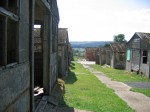 English Heritage is spending an immediate £500,000 ($775,550) to save two buildings at Harperley Prisoner of War Camp in County Durham, northeast England. Harperley was built in 1943 on requisitioned farmland by Italian PoWs who were classified as low risk or “White” prisoners. They were housed in tents when they first arrived, and then employed to construct the 50 or so Ministry of War-supply huts that would become their temporary homes. The inmates put up prefabricated walls on concrete foundations and roofed them with sheets of corrugated asbestos. Then they painted them inside and out with lead paint.
English Heritage is spending an immediate £500,000 ($775,550) to save two buildings at Harperley Prisoner of War Camp in County Durham, northeast England. Harperley was built in 1943 on requisitioned farmland by Italian PoWs who were classified as low risk or “White” prisoners. They were housed in tents when they first arrived, and then employed to construct the 50 or so Ministry of War-supply huts that would become their temporary homes. The inmates put up prefabricated walls on concrete foundations and roofed them with sheets of corrugated asbestos. Then they painted them inside and out with lead paint.
Almost as soon as the Italians finished building their camp buildings, in September of 1943 Italy surrendered to the Allies. The Harperley PoWs were transferred to other camps to await repatriation. The inmates (there were 800 to 1500 at any given time) had supplied much-needed cheap labour to area farms, mines, damming and forestry projects. By cheap labour we’re talking here about token moneys. The minimum wage for an agricultural worker in Britain at this time was 75 shillings a week. The prisoners were paid a maximum of 6 shillings a week. It was pin money, basically, enough to buy a treat once a week, not a wage.
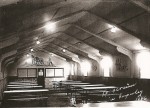 In order the fill the labour shortage, low risk “White” German PoWs were transferred to Harperley, especially after D-Day on June 6, 1944. It was the German prisoners who would leave a most beautiful stamp on these prefab huts. One of the huts they transformed into a theater, complete with orchestra pit, prompt box, proscenium arch and wings. Like a thousand German Martha Stewarts, they decorated the walls with dyed hessian sacking and basically decoupaged the backstage walls using clippings from German magazines. Another they transformed into a canteen, a lounge and game room with beautiful bucolic scenes of Germany painted on the fiberboard walls and window “curtains” made out of hardboard and painted in a checkerboard pattern.
In order the fill the labour shortage, low risk “White” German PoWs were transferred to Harperley, especially after D-Day on June 6, 1944. It was the German prisoners who would leave a most beautiful stamp on these prefab huts. One of the huts they transformed into a theater, complete with orchestra pit, prompt box, proscenium arch and wings. Like a thousand German Martha Stewarts, they decorated the walls with dyed hessian sacking and basically decoupaged the backstage walls using clippings from German magazines. Another they transformed into a canteen, a lounge and game room with beautiful bucolic scenes of Germany painted on the fiberboard walls and window “curtains” made out of hardboard and painted in a checkerboard pattern.
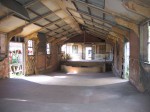 These structures were not built to last. Their expected lifetime was no more than 15 years, and most of the estimated 100 PoW camps purposely built to house prisoners (as opposed to pre-existing structures used as PoW camps) inside Britain have long since been torn down or fallen apart. Harperley is one of five known where most of the buildings are still intact, albeit in varying states of disrepair. The stags, goats, lederhosen-clad shepherd youths playing the pipes, horses frolicking have survived all these decades on the walls of the canteen building.
These structures were not built to last. Their expected lifetime was no more than 15 years, and most of the estimated 100 PoW camps purposely built to house prisoners (as opposed to pre-existing structures used as PoW camps) inside Britain have long since been torn down or fallen apart. Harperley is one of five known where most of the buildings are still intact, albeit in varying states of disrepair. The stags, goats, lederhosen-clad shepherd youths playing the pipes, horses frolicking have survived all these decades on the walls of the canteen building.
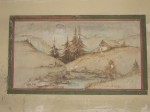
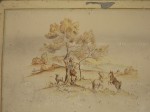

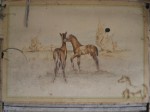
Their survival is in large part due to the land having remained in the hands of Charles Johnson, the original farmer from whom it was requisitioned, until 1999. He turned them into chicken coops for a while, but otherwise left the camp alone. After his death, the entire camp was put up for auction. It was bought in 2000 by James and Lisa McLeod who hoped to restore the 49 prison camp buildings still standing and make them into a tourist attraction/community arts center. They invested £1 million ($1.5 million) in the restoration, but ran out of money and had to stop work in 2007. In 2009 they tried to sell it on eBay for £900,000 ($1.4 million) but received no bids.
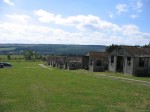 The £500,000 infusion from English Heritage, a rare grant made even though there were no matching private funds, will go directly to the conservation of the theater and canteen buildings with their unique prisoner modifications. This is just the beginning of what the camp needs to survive, so here’s hoping it inspires further donations. The McLeods hope a charitable trust will take on the entire 12 acre site to maintain this unique piece of World War II history in perpetuity.
The £500,000 infusion from English Heritage, a rare grant made even though there were no matching private funds, will go directly to the conservation of the theater and canteen buildings with their unique prisoner modifications. This is just the beginning of what the camp needs to survive, so here’s hoping it inspires further donations. The McLeods hope a charitable trust will take on the entire 12 acre site to maintain this unique piece of World War II history in perpetuity.
After the war, most prisoners were repatriated to Germany. Some of them had no homes to return to, their families gone, properties confiscated or destroyed, their hometowns under Soviet control. One in 16 German PoWs chose to remain in Britain. Harperley continued to be used as a camp for Displaced Persons after the war was over, and former prisoners continued to work for the farms and mines they had worked during the war. They married local girls and settled down.
For more about the PoW experience at Harperley, see this page or this document (pdf) from English Heritage. The beautiful pictures of the wall paintings were taken five years ago by Calroy and several are now on Google Earth.
What a gem of an article. And nobody left you any comments in the intervening 4 years since it was written… 🙁
The prisoners were lucky to have been paid even 6 shillings. Usually, it is up to the home country or POWs to make sure returning soldiers after a war get all their back pay. It is against the Geneva Convention for POWs to be used as slave labor with no pay. But let’s face it: As long as the working conditions aren’t horrendous, the soldiers are provided decent living quarters and food, I think making them work without pay is a reasonable proposition.
Anyway, those murals are wonderful. Shows the humanity of the enemy soldiers we were fighting against. Although, despite what the history Channel wants to lead the viewer to believe, German soldiers during WWII were NOT Nazis. No matter how often, obnoxiously, and loosely the History Channel slings that word around in an overly dramatic fashion, German soldiers were not heartless Nazi monsters.